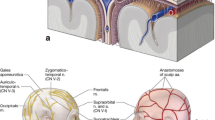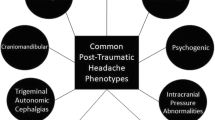Abstract
Background
Cranial neuralgias are common in the setting of posttraumatic headache. They may exacerbate underlying primary headache disorders and therefore may be overlooked in clinical practice. Frequently, cranial neuralgias generate neuropathic symptoms such as lancinating pain and sensory dysesthesias. Cranial neuralgias are identified based on a clinical history of focal neuropathic pain and physical exam findings including tenderness with palpation and percussion, at times eliciting radiating pain or paresthesias in the corresponding sensory nerve distribution.
Purpose of Review
This article is a brief review of the literature and a retrospective report of 2 cases of posttraumatic headache with associated painful cranial neuralgias.
Recent Findings
Two patients presented with headaches that met criteria for posttraumatic headache, but their history and physical examination suggested the presence of a focal painful cranial neuralgia. One patient was diagnosed with auriculotemporal neuralgia, which was exquisitely responsive to an auriculotemporal nerve block. The second patient was diagnosed with supratrochlear neuralgia, which was effectively treated with a supratrochlear nerve block. In both cases, adequate treatment of the painful cranial neuralgia resulted in significant improvement of the baseline PTH.
Summary
Painful cranial neuralgias frequently occur within the clinical spectrum of posttraumatic headache, but are often undiagnosed. Treatment options for painful cranial neuralgias are often different than those traditionally employed for posttraumatic headache without cranial neuralgias, which can include peripheral nerve blockade, neuropathic medications, and in refractory cases, peripheral nerve decompression surgery.


Similar content being viewed by others
References
Papers of particular interest, published recently, have been highlighted as: • Of importance •• Of major importance
Headache Classification Committee of the International Headache Society (IHS). The international classification of headache disorders, 3rd edition (beta version). Cephalalgia. 2013;33:629–808.
Kirov II, Whitlow CT, Zamora C. Susceptibility-weighted imaging and magnetic resonance spectroscopy in concussion. Neuroimaging Clin N Am. 2018;28(1):91–105. https://doi.org/10.1016/j.nic.2017.09.007.
Russell MB. Genetics in primary headaches. J Headache Pain. 2007;8(3):190–5. https://doi.org/10.1007/s10194-007-0389-4.
Ligthart L, Huijgen A, Willemsen G, de Geus EJC, Boomsma DI. Are migraine and tension-type headache genetically related? An investigation of twin family data. Twin Res Hum Genet. 2018;21(2):112–8. https://doi.org/10.1017/thg.2018.5.
De Simone R, Ranieri A, Bilo L, Fiorillo C, Bonavita V. Cranial neuralgias: from physiopathology to pharmacological treatment. Neurol Sci. 2008 May;29(Suppl 1):S69–78.
Mathew PG, Najib U, Khaled S, Krel R. Prevalence of occipital neuralgia at a community hospital-based headache clinic. Neurol Clin Pract. 2019. https://doi.org/10.1212/CPJ.0000000000000789Occipital Neuralgia occurred in nearly 25% of patients presenting with a chief complaint of headache to a community hospital-based headache clinic. Approximately 75% of patients with ON had a positive occipital Tinel sign on examination. Elevated body mass index, higher age at presentation, and chronic migraine increased the odds of having ON. Undiagnosed or inadequate treatment of ON can increase the frequency and intensity of other comorbid headache disorders.
Williams KA, Lawson RM, Perurena OH, Coppin JD. Management of chronic migraine and occipital neuralgia in post 9/11 combat veterans. Mil Med. 2019;184(7-8):e207–11. https://doi.org/10.1093/milmed/usy405.
Gfrerer L, Hansdorfer MA, Ortiz R, Chartier C, Nealon KP, Austen WG Jr. Muscle fascia changes in patients with occipital neuralgia, headache, or migraine. Plast Reconstr Surg. 2021;147(1):176–80.
Burstein R, Blake P, Schain A, Perry C. Extracranial origin of headache. Curr Opin Neurol. 2017 Jun;30(3):263–71.
Mathew PG, Najib U, Khaled S, Krel R. The diagnosis in the back of your head: the prevalence of occipital neuralgia at a community hospital based headache clinic. American Headache Society Annual Scientific Meeting, San Francisco, CA, June 2018. In patients with occipital neuralgia, 6 cc occipital nerve blocks should be considered given the average duration of pain remission of 206.95 days and lack of significant adverse events. When occipital neuralgia is due to nerve compression, smaller volume ONB may not generate adequate hydrodynamic pressure to sufficiently decompress the affected nerves.
Jose A, Nagori SA, Chattopadhyay PK, Roychoudhury A. Greater occipital nerve decompression for occipital Neuralgia. J Craniofac Surg. 2018;29(5):e518–21. https://doi.org/10.1097/SCS.0000000000004549In patients with refractory occipital neuralgia with limited responses to large volume occipital nerve blocks, surgical decompression should be considered.
Krel R, Mathew PG. Procedural treatments for headache disorders. Pract Neurol (US). 2019;18(4):76–9 (Images created by Anne M. Sydor, PhD and reproduced with permission).
Author information
Authors and Affiliations
Corresponding author
Ethics declarations
Conflict of Interest
Dr. Mathew has served as a consultant for Allergan, Amgen, Biohaven, Eli Lilly, Revance, Satsuma, Supernus, and Theranica.
Dr. Cooper has served as a consultant for Allergan, Amgen, Biohaven, Dolor Technologies, Eli Lilly, Teva, and Theranica.
Additional information
Publisher’s Note
Springer Nature remains neutral with regard to jurisdictional claims in published maps and institutional affiliations.
This article is part of the Topical Collection on Concussion and Head Injury
Rights and permissions
About this article
Cite this article
Mathew, P.G., Cooper, W. The Diagnosis and Management of Posttraumatic Headache with Associated Painful Cranial Neuralgias: a Review and Case Series. Curr Pain Headache Rep 25, 54 (2021). https://doi.org/10.1007/s11916-021-00969-w
Accepted:
Published:
DOI: https://doi.org/10.1007/s11916-021-00969-w




